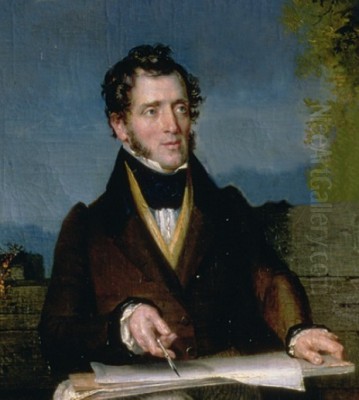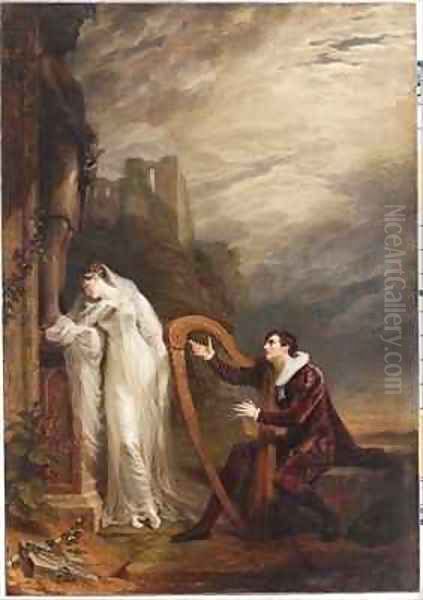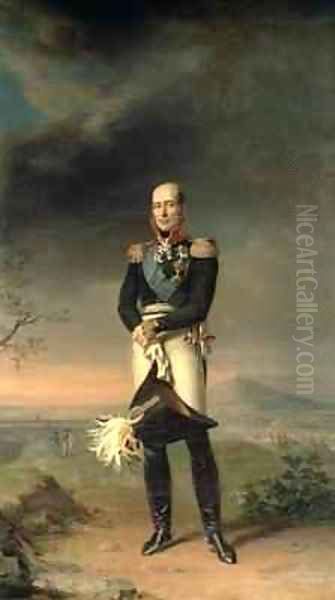
George Dawe RA (1781–1829) stands as a significant, if sometimes overlooked, figure in the annals of British and European portraiture. An English artist who achieved remarkable fame both at home and, most notably, in Imperial Russia, Dawe's career was characterized by prodigious output, a keen ability to capture the likeness and character of his sitters, and a monumental project that immortalized the heroes of the Napoleonic Wars. His life and work offer a fascinating window into the artistic tastes, social currents, and historical upheavals of the late Georgian and Regency periods.
Early Life and Artistic Foundations
Born in St James's, Westminster, London, on February 8, 1781, George Dawe was immersed in the world of art from his earliest years. His father, Philip Dawe, was a respected mezzotint engraver and political cartoonist who had worked with the renowned William Hogarth. This familial connection to the visual arts undoubtedly shaped young George's inclinations. He also had a younger brother, Henry Edward Dawe, who would also become a painter and engraver.
Dawe's formal artistic training began at a young age. He was initially apprenticed to his father, learning the intricacies of engraving. However, his ambitions lay in painting. He enrolled in the prestigious Royal Academy Schools in 1794, at the tender age of thirteen, demonstrating early promise. There, he would have been exposed to the teachings and works of leading figures of the British art establishment, including the Academy's president, Benjamin West, an American-born painter famed for his historical scenes. Other influential figures whose work would have been studied included Sir Joshua Reynolds, the first president of the Royal Academy, and Thomas Gainsborough, both of whom had set formidable standards in British portraiture.
Dawe proved to be a diligent student. In 1803, he won the Royal Academy's coveted gold medal for his historical painting, Achilles frantic for the loss of Patroclus, rejecting the consolation of Thetis. This success signaled his potential in the highly esteemed genre of history painting, which was considered the noblest form of art at the time.
Early Career in England

Following his success at the Royal Academy Schools, Dawe began to establish his career. His early works included subject pictures drawn from literature and history, such as Naomi and her Daughters and Genevieve. He exhibited regularly at the Royal Academy and the British Institution. While he demonstrated skill in these narrative compositions, the demand for portraiture in Britain was immense, offering more consistent financial rewards and opportunities for patronage.
Gradually, Dawe shifted his focus towards portrait painting. He began to attract notable clients, including members of the aristocracy and prominent public figures. His ability to produce strong likenesses, combined with a certain romantic sensibility in his portrayal of sitters, gained him recognition. He was elected an Associate of the Royal Academy (ARA) in 1809, a significant step in his career, and a full Royal Academician (RA) in 1814.
During this period in England, Dawe's style evolved. While influenced by the grand manner of Reynolds and the fluid elegance of Sir Thomas Lawrence, who was rapidly becoming the dominant portrait painter of the age, Dawe developed his own distinct approach. His portraits often possessed a robust quality and a directness that appealed to his patrons. He painted, for example, portraits of the Duke and Duchess of Kent, and Princess Charlotte and Prince Leopold, which were well-received.
Despite his growing success, Dawe operated in a competitive environment. Sir Thomas Lawrence was the undisputed star of British portraiture, sought after by royalty and the elite. Other notable portraitists of the time included John Hoppner, who had been a rival to Lawrence until his death in 1810, and the Scottish master Henry Raeburn, known for his vigorous and insightful character studies. William Beechey also enjoyed considerable royal patronage. Dawe carved out his niche, but his greatest fame was yet to come, and it would be found far from British shores.
The Russian Sojourn: The Military Gallery
The turning point in George Dawe's career, and the project for which he is most remembered, came with an invitation from Tsar Alexander I of Russia. In 1818, Dawe accompanied the Duke of Kent on a trip to the continent. During this journey, he was presented to Tsar Alexander I in Aix-la-Chapelle. The Tsar, deeply impressed by Dawe's talent, commissioned him to paint a series of portraits of the senior Russian military commanders who had played pivotal roles in the defeat of Napoleon Bonaparte.

This commission was for the creation of the Military Gallery (Военная галерея) in the Winter Palace, St. Petersburg. It was an undertaking of immense scale and historical significance, intended to be a lasting memorial to Russia's triumph in the Napoleonic Wars, particularly the Patriotic War of 1812. Dawe relocated to St. Petersburg in 1819 to commence this monumental task.
For nearly a decade, from 1819 to 1828, Dawe dedicated himself to this project. He painted an astonishing 329 bust-length portraits of generals, as well as larger equestrian portraits of Tsar Alexander I and his brother, Grand Duke Constantine. The gallery also included portraits of Emperor Francis I of Austria and King Frederick William III of Prussia, Russia's allies in the Napoleonic conflict. The sheer volume of work was staggering. To manage it, Dawe employed assistants, notably Alexander Polyakov and Wilhelm August Golicke, who often painted the uniforms and backgrounds, while Dawe himself focused on the faces, ensuring the likeness and capturing the character of each individual.
His portraits for the Military Gallery are characterized by their vitality and psychological insight. Dawe had a remarkable ability to convey the sitter's personality and experience, often with a dramatic flair that suited the heroic subject matter. Notable portraits from this series include those of Field Marshal Mikhail Kutuzov, Prince Pyotr Bagration, and Barclay de Tolly. He depicted these military heroes with a sense of dignity and strength, their faces often reflecting the trials of war. The uniforms were rendered with meticulous detail, adding to the grandeur and historical accuracy of the collection.
During his time in Russia, Dawe became a celebrated figure in St. Petersburg society. He was held in high esteem by the Tsar and the imperial court, and his studio was a hub of activity. He was made an honorary member of the Imperial Academy of Arts in St. Petersburg. His success in Russia was unparalleled for a foreign artist at the time. He not only fulfilled his commission for the Military Gallery but also undertook private commissions from Russian aristocrats. His work was seen as embodying a modern, dynamic style of portraiture that resonated with the spirit of the age.
Artistic Style and Technique
George Dawe's artistic style is best understood as a product of the late Neoclassical and emerging Romantic movements. His training at the Royal Academy would have instilled in him the principles of Neoclassicism, with its emphasis on clarity, order, and idealized form, often drawing inspiration from classical antiquity. This is evident in the structured composition of some of his earlier works and the clear delineation of features in his portraits.
However, Dawe's work, particularly his portraiture, increasingly embraced elements of Romanticism. This movement, which gained momentum in the early 19th century, prioritized emotion, individualism, and the glorification of the past and nature. In Dawe's portraits, this Romantic sensibility is manifest in the dramatic lighting, the expressive rendering of his sitters' faces, and the attempt to convey their inner character and psychological depth. He was less concerned with flattering his subjects in a conventional sense than with capturing a sense of their presence and personality.
His brushwork could be fluid and energetic, particularly in the rendering of drapery and backgrounds, while the faces were often treated with more precision to ensure a strong likeness. He had a good sense of color, often employing rich tones, especially in the depiction of military uniforms with their vibrant reds, blues, and golds, accented by the gleam of medals and epaulets. The use of chiaroscuro, or strong contrasts between light and shadow, added a sense of drama and volume to his figures.
Compared to the polished elegance of Sir Thomas Lawrence, Dawe's style could appear more robust and direct. While Lawrence was famed for his sophisticated glamour and elongated, graceful figures, Dawe's portraits often had a more grounded, tangible quality. He excelled at portraying men of action, and his work in the Military Gallery perfectly suited his talents. He managed to create a sense of individuality within the uniformity of the commission, giving each general a distinct presence.
His early historical paintings, like Achilles frantic for the loss of Patroclus, show his academic training and his ambition to tackle grand themes. These works often featured dynamic compositions and expressive figures, prefiguring the dramatic qualities he would later bring to his portraiture.
Contemporaries and Connections
George Dawe's career unfolded during a vibrant period in European art. In Britain, as mentioned, Sir Thomas Lawrence was the preeminent portrait painter. Dawe's relationship with Lawrence would have been one of professional respect and, inevitably, rivalry. Other British contemporaries included Henry Raeburn in Scotland, whose portraits were known for their psychological depth and vigorous handling, and John Hoppner, who, until his death, was a significant competitor to Lawrence. Benjamin West, as President of the Royal Academy, remained an influential figure, though his focus was more on historical painting. J.M.W. Turner and John Constable were revolutionizing landscape painting during this same period, though their artistic concerns were different from Dawe's.
In Russia, Dawe arrived at a time when Russian art was developing its own national school. He would have been aware of the work of established Russian portraitists like Vladimir Borovikovsky, whose style blended sentimentalism with Neoclassical elegance. A younger generation of Russian artists was also emerging, including Orest Kiprensky, who is often considered one of Russia's greatest Romantic portraitists. Kiprensky's work, like Dawe's, emphasized psychological insight and expressive power. Dawe's presence and success in St. Petersburg undoubtedly had an impact on the local art scene, introducing a directness and dynamism that was admired.
On the broader European stage, the Napoleonic era had seen the dominance of French Neoclassicism, epitomized by Jacques-Louis David. David's pupils, such as Jean-Auguste-Dominique Ingres, were continuing and evolving this tradition. In Spain, Francisco Goya was creating powerful and often disturbing images that chronicled the turmoil of his times, including deeply insightful portraits. Dawe's work, while rooted in the British tradition, shared with these European contemporaries an engagement with the significant historical figures and events of the age. His focus on capturing the character of military leaders resonated with a wider European interest in heroism and national identity in the wake of the Napoleonic Wars.
Dawe was also a writer on art. He published "The Life of George Morland, with Remarks on His Works" in 1807, a biography of the popular, albeit troubled, genre painter. This indicates his engagement with the broader art world beyond his own practice.
Later Years and Return to England
After nearly a decade of intensive work in Russia, George Dawe returned to England in 1828. His health had reportedly begun to decline, possibly due to the demanding nature of his work and the harsh Russian climate. He brought with him a considerable fortune and an international reputation.
Upon his return, he sought to re-establish himself in the London art scene. However, his time in England was to be short-lived. He continued to paint and exhibit, but his health problems persisted.
George Dawe died on October 15, 1829, in Kentish Town, London, at the relatively young age of 48. He was buried in the crypt of St Paul's Cathedral, a prestigious resting place that reflected his status as a Royal Academician and a painter of national and international renown. His funeral was attended by many distinguished artists, including J.M.W. Turner, who was a pallbearer.
Legacy and Historical Significance
George Dawe's most enduring legacy is undoubtedly the Military Gallery in the Winter Palace. This collection remains a unique and invaluable historical document, providing a visual record of the men who led Russia's armies against Napoleon. The gallery is a powerful testament to a pivotal moment in Russian and European history, and Dawe's portraits are central to its impact. His work in Russia earned him lasting fame there, and he is still highly regarded in Russian art history.
In Britain, Dawe's reputation has perhaps been somewhat overshadowed by that of Sir Thomas Lawrence. Lawrence's dazzling style and extensive patronage from the British elite secured him a preeminent place in the history of British portraiture. However, Dawe's achievements were substantial. He was a highly skilled and prolific painter who successfully navigated the competitive London art world and achieved extraordinary success abroad.
His ability to capture not just a likeness but also the character and spirit of his sitters was a hallmark of his work. He brought a sense of drama and psychological intensity to his portraits, particularly those of military figures, which set him apart. While he may not have been as innovative as some of his contemporaries in terms of artistic style, his contribution lies in the quality and historical importance of his oeuvre.
Dawe's career also highlights the international nature of the art world in the early 19th century and the opportunities available to ambitious artists. His decade in Russia was a remarkable chapter, demonstrating the high regard in which British portraiture was held on the continent.
His work continues to be studied by art historians and is represented in major collections, including the State Hermitage Museum in St. Petersburg (which houses the Military Gallery), the National Portrait Gallery in London, and the Royal Collection. Through his art, George Dawe provided a vivid portrait of an era of conflict, heroism, and profound social change.
Anecdotes and Personal Glimpses
While detailed personal anecdotes about George Dawe are not as plentiful as for some of his more flamboyant contemporaries, certain aspects of his working life and character emerge from historical accounts.
His capacity for work was evidently enormous. The sheer number of portraits he produced for the Military Gallery in less than ten years—over three hundred—speaks to a disciplined and relentless work ethic. This output was facilitated by his studio assistants, but Dawe himself was responsible for the crucial elements of each portrait, particularly the faces.
It is said that Tsar Alexander I held Dawe in such high regard that he would often visit the artist's studio in the Winter Palace unannounced, taking a keen interest in the progress of the Military Gallery. This close relationship with such a powerful patron was crucial to Dawe's success in Russia.
Dawe was known for his ability to work quickly and efficiently, a valuable skill when dealing with busy military commanders who had limited time for sittings. He developed a system for capturing their likenesses effectively, often focusing on achieving a strong, characterful depiction rather than an overly idealized one.
There are suggestions that Dawe was a somewhat reserved and serious individual, dedicated to his art. His decision to spend a significant portion of his career in a foreign country, away from the familiar artistic circles of London, indicates a strong sense of purpose and perhaps a degree of adventurousness.
His early success with the historical painting Achilles frantic for the loss of Patroclus demonstrates his ambition to excel in the most prestigious genre of his time. Although he ultimately became famous as a portraitist, this early grounding in narrative and historical subjects likely informed his ability to imbue his portraits with a sense of drama and significance.
The fact that J.M.W. Turner, one of Britain's greatest painters, served as a pallbearer at Dawe's funeral suggests the respect he commanded among his peers in the Royal Academy, even if his fame in Britain was somewhat eclipsed by his renown in Russia.
Conclusion
George Dawe RA was an artist of considerable talent and remarkable industry. From his early training in his father's engraving studio and the Royal Academy Schools, he rose to become a respected portrait painter in England and a celebrated figure in Imperial Russia. His monumental work for the Military Gallery in St. Petersburg stands as his crowning achievement, a vast pictorial chronicle of a generation of military leaders who shaped European history.
While his style blended Neoclassical foundations with Romantic expressiveness, Dawe's true strength lay in his ability to capture the individual character and presence of his sitters. He provided a powerful visual record of the men of an era defined by war and its aftermath. Though perhaps not as stylistically innovative as some of his contemporaries like Turner or Constable in their respective fields, or as pervasively influential in Britain as Sir Thomas Lawrence, Dawe's contribution to portraiture and historical documentation is undeniable. His life and work remind us of the vital role artists play in recording and interpreting their times, creating legacies that endure long after their subjects have passed into history. George Dawe, through his brush, indeed painted a vivid portrait of an unforgettable era.